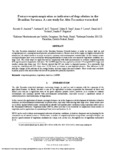Please use this identifier to cite or link to this item:
http://www.alice.cnptia.embrapa.br/alice/handle/doc/1001283Full metadata record
| DC Field | Value | Language |
|---|---|---|
| dc.contributor.author | ANDRADE, R. G. | pt_BR |
| dc.contributor.author | TEIXEIRA, A. H. de C. | pt_BR |
| dc.contributor.author | SANO, E. E. | pt_BR |
| dc.contributor.author | LEIVAS, J. F. | pt_BR |
| dc.contributor.author | VICTORIA, D. de C. | pt_BR |
| dc.contributor.author | NOGUEIRA, S. F. | pt_BR |
| dc.date.accessioned | 2014-12-02T11:11:11Z | pt_BR |
| dc.date.available | 2014-12-02T11:11:11Z | pt_BR |
| dc.date.created | 2014-12-02 | pt_BR |
| dc.date.issued | 2014 | pt_BR |
| dc.identifier.citation | Proceedings of SPIE, v. 9239, p. 92391Z-1 - 92391Z-7, 2014. | pt_BR |
| dc.identifier.isbn | 0277-786X | pt_BR |
| dc.identifier.uri | http://www.alice.cnptia.embrapa.br/alice/handle/doc/1001283 | pt_BR |
| dc.description | The Alto Tocantins watershed, located in the Brazilian Savanna (Cerrado biome), is under an intense land use and occupation process, causing increased pressure on natural resources. Pasture areas in the region are highly relevant to the rational use of natural resources in order to achieve economic and environmental sustainability. In this context, remote sensing techniques have been essential for obtaining information relevant to the assessment of vegetation conditions on a large scale. This study aimed to apply this tool in conjunction with field measurements to evaluate evapotranspiration (ET) against pasture degradation indicators. The SAFER algorithm was applied to estimate ET using MODIS images and weather station data from year 2012. Results showed that ET was lower in degraded pastures. It is noteworthy that during low rainfall period, ET values were 22.2% lower in relation to non-degraded pastures. This difference in ET indicates changes in the partition of the energy balance and may impact the microclimate. These results may contribute to public policies that aim to reduce the loss of the productive potential of pastures. | pt_BR |
| dc.language.iso | eng | eng |
| dc.rights | openAccess | eng |
| dc.subject | SAFER | pt_BR |
| dc.title | Pasture evapotranspiration as indicators of degradation in the Brazilian Savanna. A case study for Alto Tocantins watershed. | pt_BR |
| dc.type | Artigo de periódico | pt_BR |
| dc.date.updated | 2014-12-02T11:11:11Z | pt_BR |
| dc.subject.nalthesaurus | Evapotranspiration | pt_BR |
| dc.subject.nalthesaurus | Vegetation | pt_BR |
| dc.subject.nalthesaurus | Land use | pt_BR |
| dc.description.notes | Presented at the 16th Remote Sensing for Agriculture, Ecosystems, and Hydrology. | pt_BR |
| riaa.ainfo.id | 1001283 | pt_BR |
| riaa.ainfo.lastupdate | 2014-12-02 | pt_BR |
| dc.identifier.doi | 10.1117/12.2067225 | pt_BR |
| dc.contributor.institution | RICARDO GUIMARAES ANDRADE, CNPM; ANTONIO HERIBERTO DE C TEIXEIRA, CNPM; EDSON EYJI SANO, CPAC; JANICE FREITAS LEIVAS, CNPM; DANIEL DE CASTRO VICTORIA, CNPM; SANDRA FURLAN NOGUEIRA, CNPM. | pt_BR |
| Appears in Collections: | Artigo em periódico indexado (CNPM)  | |










